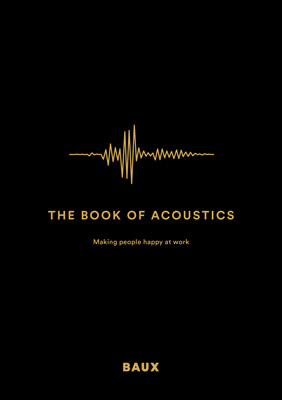10.0 Glossary of Acoustic Terms
10.0 Glossary of Acoustic Terms
Absorption
When a sound wave encounters a surface and the energy is absorbed by the surface rather than reflected.
Absorption coefficient
A measurement used to evaluate the sound absorption efficiency of materials.
Acoustics
The science of sound; a branch of physics dealing with mechanical waves.
Amplification
Increasing the volume of sound.
Audio
Sound, transmitted in the form of signals.
Auditory system
The body system responsible for the sense of hearing.
Aural
Related to the sense of hearing.
Auralisation
The modelling and simulation of acoustic phenomena rendered as a soundfield in a virtualized space.
Anechoic
Free from echoes.
Bandwidth
A measure of the width of a range of frequencies, measured in Hertz.
Binaural
Relating to hearing involving two ears. Human hearing is binaural, which allows the listener to determine the direction and origin of sound.
Block
Sound blocking is the introduction of barriers that prevent the travel of sound waves from one space to another.
Cover
An acoustic treatment by which noise is masked by another layer of sound, such as a water feature in a public space or pre-recorded music played on a speaker system.
Dampening
Used variably to describe either absorption, diffusion and/or blocking of sound to achieve a more quiet and less resonant acoustic environment.
Decibel (dB)
A standard unit used to measure the intensity of sound.
Density
The degree to which a material is compact, which can affect the extent to which it allows sound to pass through it.
Diffraction
The bending of sound waves around obstacles and the spreading out of sound waves beyond openings.
Diffusion
The spreading out of sound waves to achieve a more “even” acoustic environment.
Dispersion
Where a sound wave separates into its component frequencies as it passes through a material.
Echo
The sound caused by the reflection of sound waves, which arrives at the listener later than the original sound.
Environmental noise
The accumulation of noise pollution that occurs outside.
Frequency (Hz)
The speed of vibration which determines the pitch of a sound, measured in Hertz.
Intelligibility
A measure of how comprehensible speech is in given conditions.
Interference
A phenomenon in which two waves superpose to form a resultant wave of greater, lower, or the same amplitude.
Loudness
The subjective perception of sound pressure.
Mechanical wave
A wave that is an oscillation of matter, and therefore transfers energy through a medium. Sound waves are a type of mechanical wave.
Noise
Sound, particularly that which is loud, unpleasant or causes disturbance.
Noise Rating curve
A standard determining the acceptable level of sound in an interior environment for hearing preservation and verbal communication.
Noise reduction coefficient (NRC)
A representation of the amount of sound energy absorbed upon striking a particular surface, measured on scale between 0 and 1 where NRC 0 = complete reflection and NRC 1 = complete absorption.
Oscillation
Repeatedly and regularly fluctuating above and below a mean value. Sound oscillates as it travels, hence the wave pattern.
OSHA
Occupational Safety and Health Administration, the body responsible for setting the acceptable limit of noise exposure for workers in the USA.
Psychoacoustics
The study of the psychological and physiological effects of sound on human beings.
Room absorption
The sum of Sabine absorption due to objects and surfaces in a room.
Reflection
When a sound wave hits a surface, it reflects, either in a relatively straight line or in scattered pattern, depending on the texture and density of the surface.
Refraction
Acoustic refraction, in which the path of sound waves is redirected, occurs when sound waves enter a medium in which their speed changes. The temperature of the air, for instance, can cause sound waves to be refracted.
Resonance
The reinforcement or prolongation of sound by reflection from a surface, or by the synchronous vibration of a neighbouring object.
Resonator
A device or system that exhibits resonance or resonant behaviour.
Reverberation
The persistence of sound after the sound is produced. Created when a sound is reflected, causing numerous reflections to build up then decay as the sound is absorbed by surrounding surfaces and objects.
Reverberation time
The lifetime or persistence of a sound wave in an enclosed space.
Room acoustics
A broad term representing how sound behaves in an enclosed environment.
Sabine
Unit of sound absorption, named after Wallace Clement Sabine, founder of the field of architectural acoustics.
Sabine formula
Formula developed by Wallace Clement Sabine that allows designers to plan reverberation time in a space prior to construction and occupancy.
Sound absorption class
A set of internationally recognised sound classes for materials, ranked from A to E. A higher ranking sound class (A) is not necessarily better, depending on the needs of the project.
Sound absorption coefficient
Alternative name for the Noise Reduction Coefficient (NRC) described above.
Sound wave
Longitudinal wave consisting of areas of high and low air pressure.
Soundscape
A sound or combination of sounds
Soundproof
To reduce or eliminate the transfer of sound from one area to another.
Transmission
The movement of sound through and between materials.
Ultrasound
Sound waves with frequencies above the human hearing capacity, often used in medicine.
Wood wool
A common material in acoustic design, made of processed timber, that absorbs sound when installed on interior surfaces.
